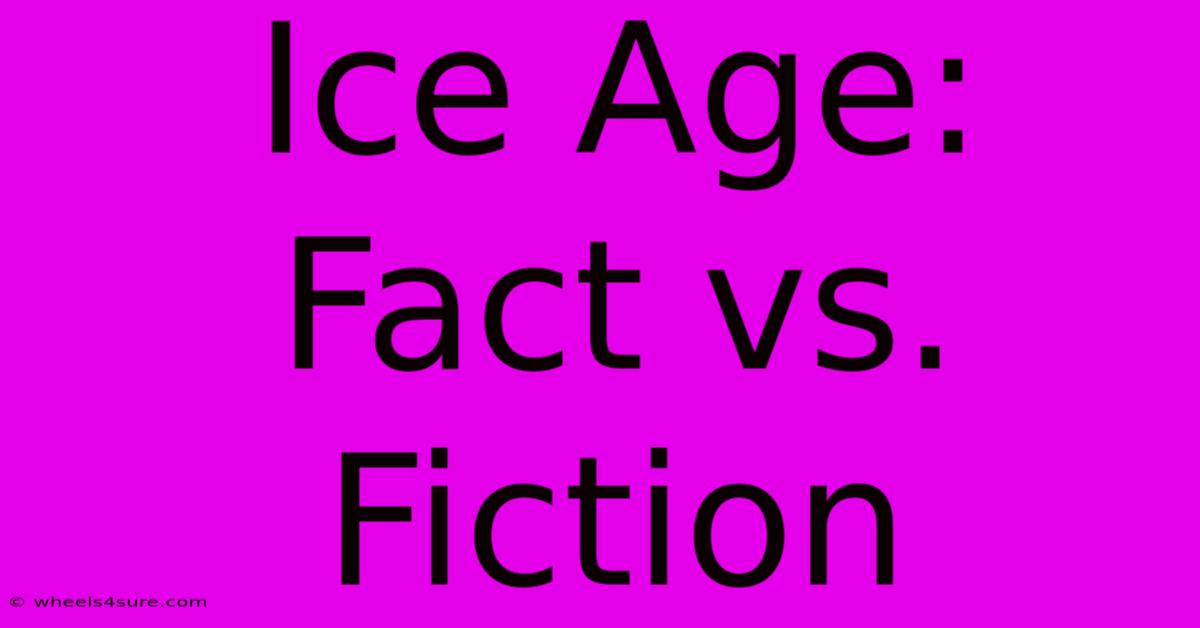Ice Age: Fact Vs. Fiction

Table of Contents
Ice Age: Fact vs. Fiction
The captivating "Ice Age" films depict a world dominated by massive glaciers, woolly mammoths, and saber-toothed cats. But how much of this cinematic spectacle reflects the reality of past ice ages? Let's delve into the fascinating comparison between the fictional portrayal and the actual scientific understanding of these glacial periods.
The Reality of Ice Ages: A Deep Freeze
Ice ages, or glacial periods, are intervals of long-term reduction in Earth's temperature, resulting in the expansion of continental and polar ice sheets and glaciers. These aren't singular events but rather cycles that have occurred repeatedly throughout Earth's history. The most recent ice age, the Quaternary glaciation, began roughly 2.6 million years ago and continues to this day (we're currently in an interglacial period, a warmer phase within an ice age).
Key Features of Real Ice Ages:
- Glacial Advance and Retreat: Ice sheets advanced and retreated over vast areas, dramatically reshaping landscapes. Evidence of this is found in glacial landforms like moraines, U-shaped valleys, and fjords.
- Sea Level Changes: During glacial maxima (periods of maximum ice extent), massive amounts of water were locked up in ice, causing sea levels to drop significantly. Conversely, during interglacial periods, sea levels rose.
- Megafauna: Ice ages supported unique megafauna, including mammoths, mastodons, saber-toothed cats, giant ground sloths, and woolly rhinoceroses. These animals adapted to the harsh, cold conditions.
- Climate Fluctuations: Ice ages weren't characterized by uniform cold. There were significant climate fluctuations, with periods of both extreme cold and relatively milder conditions.
- Human Adaptation: Early humans lived through and adapted to multiple ice ages, developing technologies and strategies to survive the challenging environments.
Ice Age: The Movie - A Creative License
The "Ice Age" franchise takes creative liberties with the scientific reality. While it captures the essence of a glacial period with its icy landscapes and megafauna, several aspects are fictionalized for entertainment purposes.
Fictional Elements in "Ice Age":
- Animal Companionship: The film's central narrative relies on unlikely friendships between disparate species – a mammoth, a sloth, and a saber-toothed tiger. While these animals coexisted, their interactions weren't likely as amicable or collaborative as depicted.
- Anthropomorphism: The animals are highly anthropomorphized, exhibiting human-like emotions, behaviors, and speech. This is purely a creative choice for storytelling.
- Exaggerated Animal Sizes: While the animals are depicted as large, their sizes might be exaggerated for dramatic effect.
- Simplified Environments: The movie simplifies the diverse and complex ecosystems of the ice age.
- Human Absence: In the earlier films humans are not featured heavily which is only partially reflective of early human existence during ice ages, especially in some regions.
Bridging Fact and Fiction: The Value of "Ice Age"
Despite its creative liberties, the "Ice Age" franchise plays a valuable role in sparking interest in paleontology and the history of ice ages. By showcasing the megafauna of the Pleistocene epoch, the films encourage viewers to learn more about these fascinating creatures and the environments they inhabited.
Educational Opportunities:
- Inspiring Curiosity: The captivating visuals and storyline can inspire young viewers to investigate the science behind ice ages.
- Raising Awareness: The movies contribute to broader awareness about the impact of climate change, showcasing the sensitivity of ecosystems to temperature fluctuations.
- Understanding Adaptation: The film subtly illustrates how animals adapted to their environment, prompting further exploration of evolutionary biology.
In conclusion, while the "Ice Age" films are fictional narratives, they provide an engaging introduction to the fascinating world of past ice ages. By understanding the balance between the film's creative liberties and the scientific realities, we can appreciate both the entertainment value and the educational potential of this popular franchise. Further research into paleoclimatology and paleontology will reveal the rich complexity of these periods in Earth's history, enriching our understanding of our planet's dynamic past and informing our present actions regarding climate change.

Thank you for visiting our website wich cover about Ice Age: Fact Vs. Fiction. We hope the information provided has been useful to you. Feel free to contact us if you have any questions or need further assistance. See you next time and dont miss to bookmark.
Featured Posts
-
Understanding Your Body The Male Reproductive Parts
Apr 05, 2025
-
Charles Mansons Son Breaking Free From The Past
Apr 05, 2025
-
Discover The Daughters Of Prophet Muhammad Their Lives And Legacy
Apr 05, 2025
-
Free Fire Ka Dads Top 5 Weapon Picks
Apr 05, 2025
-
Kusah Age Enjoy The Journey
Apr 05, 2025
